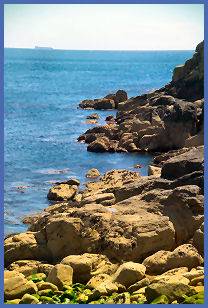Lamorna Cove
OS Grid ref:- SW451241
 Beautiful
and secluded Lamorna Cove, known in the Cornish language as Nansmornow, lies on the Penwith peninsula six miles from the town of Penzance, the cove has a small rocky beach, where there is sand at low tide and a quay.
Beautiful
and secluded Lamorna Cove, known in the Cornish language as Nansmornow, lies on the Penwith peninsula six miles from the town of Penzance, the cove has a small rocky beach, where there is sand at low tide and a quay.
There are various footpaths in the area, in addition to the coastal path running through Lamorna from the characterful village of Mousehole to Porthcurno.
 The picturesque cove has been popular in the past with artists, craftsmen and potters, the artist Samuel John Birch loved the place so much he even added Lamorna to his name. In the late nineteenth and early twentieth centuries Lamorna became popular with artists of the Newlyn School. 'Lamorna' Birch lived there from 1908. The colony also included Alfred Munnings, Laura Knight and Harold Knight. Even Augustus John was a visitor to the settlement.
The picturesque cove has been popular in the past with artists, craftsmen and potters, the artist Samuel John Birch loved the place so much he even added Lamorna to his name. In the late nineteenth and early twentieth centuries Lamorna became popular with artists of the Newlyn School. 'Lamorna' Birch lived there from 1908. The colony also included Alfred Munnings, Laura Knight and Harold Knight. Even Augustus John was a visitor to the settlement.
Lamorna Cove is situated at the base of the Lamorna Valley which is fed by a trout stream which runs down to the sea. A few characterful cottages with colourful gardens and an inn line the narrow lane.
 The hamlet has a pub, "The Wink", which name alludes to the smuggling activities which once took place in the area, "the wink" being a signal that contraband could be obtained. The pub is the subject of a novel by Martha Grimes, entitled The Lamorna Wink. The interior contains an important collection of maritime artefacts, including the nameplate of the battleship Warspite.There are spectacular views from the coast path to the west, while the walk from Lamorna Cove to Land's End is particularly stunning.
The hamlet has a pub, "The Wink", which name alludes to the smuggling activities which once took place in the area, "the wink" being a signal that contraband could be obtained. The pub is the subject of a novel by Martha Grimes, entitled The Lamorna Wink. The interior contains an important collection of maritime artefacts, including the nameplate of the battleship Warspite.There are spectacular views from the coast path to the west, while the walk from Lamorna Cove to Land's End is particularly stunning.
Above Lamorna Cove is Boleigh, the site of the last battle between the Cornish and the English. A revolt against the Anglo-Saxons in 931 AD by the Cornish Celts (supported by the Danes) led to a battle which took place in the area where a farm and hamlet now stands. The Saxon king Athelstan crushed the resistance, before continuing on to conquer the Isles of Scilly. A local story tells of ancient armour being ploughed up in the nearby fields at Gul Reeve (a corruption of the Cornish Gwel Ruth, meaning red field). After the battle the Saxon King Athelstan of Wessex granted a charter to found a collegiate church at St. Buryan.
Several interesting archaeological sites lie nearby including the Merry Maidens Stone Circle and The Pipers at Boleigh, a pair of standing stones situated 2 miles (3 km) to the south of the village of St Buryan.The name of these two stones derives from a local legend that they were two pipers who were turned to stone for playing music on the Sabbath for the nearby dancing Merry Maidens. Another legend states that the two stones were set up following the tenth century battle in which the Anglo-Saxon English led by Athelstan, fought the Cornish Celts, led by Howel and supported by the Danes. The Pipers were said to mark the burial positions of the two opposing leaders.
Towns and Villages of Cornwall